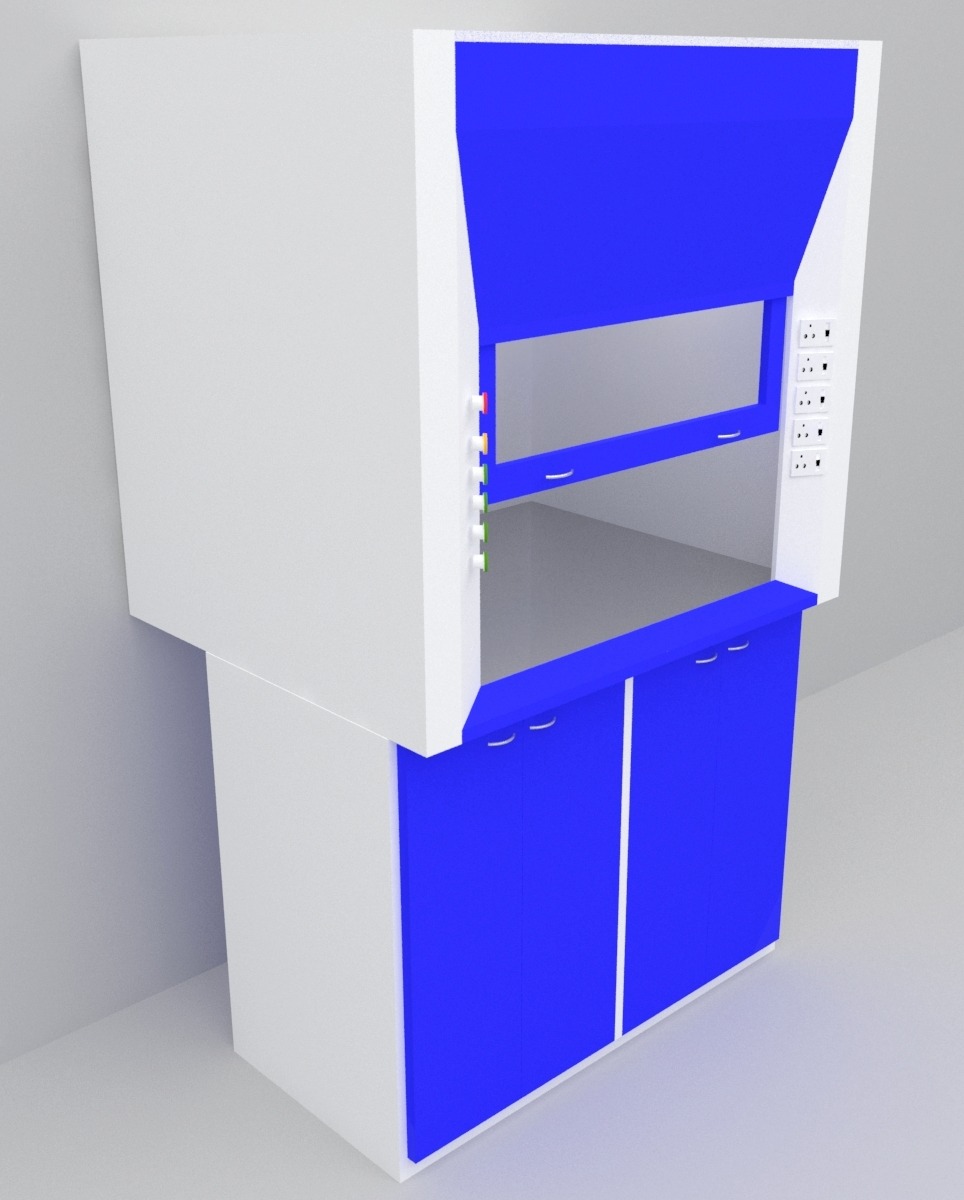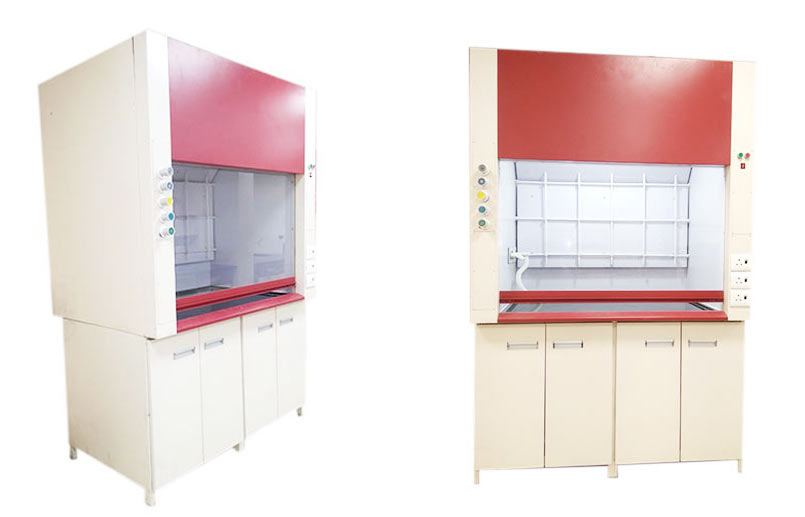In laboratories, scientists do a lot of experiments, and some of them can be dangerous. Poisonous gasses are always a problem in chemistry laboratories. This is where a fume hood (or a fume cabinet or fume cupboard) comes in handy. Today, we will discuss everything about fume hoods in detail.

Definition of a Fume Hood
A fume hood is a special type of laboratory work equipment with an enclosure on top that can contain the effects of the experiment being run within it. It is designed to ensure safety for the user and other inhabitants of the room, and it should be able to filter out any harmful gasses. A fume hood may also provide protection from small explosions or splashes. It must have a built-in mechanism to strongly suck the gasses out of the working area within the enclosure.
Fume Hood Description
Basically, a fume hood is just a large box on top of a lab workbench . This box has a large door or shutter at one side, and may or may not have glass or CRCA sheet walls on other sides. If you need to display some dangerous kind of experiment to an audience on top of an island-type lab table, then you need a glass-walled chamber; or else a wall-facing metal fume cabinet is fine.
As the fume hood needs to suck the air out of the box, it generally has an exhaust fan or air pump inside it above the work area, and a sealed vent pipe connected to it that goes to the outside atmosphere, or to a filter block. There are some types of fume hoods that don’t need a vent or air ducts; we’ll cover them soon.
The lower part of a fume hood, essentially the area under the table can be utilized too. We can put some under-table storage cabinets in there, or we can keep it open as well.
Working Principle of a Fume Hood
The functions of a fume hood are as follows:
- To protect the user from inhaling toxic fumes
- To protect the experiment or sample from contamination
- To protect the user from explosions or spills
To achieve the above, a fume hood has three main parts ‒ the table, the enclosure, and the system.
The table is generally a standard CRCA made C-frame or H-Frame work, with under-table storage like shuttered cabinets and/or drawers, where you can keep some lab equipment . The enclosure also is CRCA-made; with a glass shutter at one side. The glass in the shutter should be of good quality ‒ some advanced models may even be explosion-proof.

Inside the fume hood, there are facilities to let you work. For example, there is almost always some good lighting system in the cabinet. There should be LPG and water connections in the hood, and a drain too in case of spills.
The air suction system is generally placed on top of the box or on the backside (the side towards the wall). This system is generally made up of a strong exhaust fan or air pump and accompanying air duct. The strength of the pump lies in the airflow strength ‒ starting from 4 to 8 meters per second to more.
When the exhaust is running, it sucks in volumes of air through the open side (never run the exhaust with the hood completely closed) and vents it through the duct. The duct may throw the fumes right outside the room in the air, or may run it through a filtration system, depending upon the severity of the experiment.
Some advanced laboratory fume hoods have microcontrollers inside them, which you can use to control the exhaust. You may set various suction levels for given setups and later use these quick setups for particular experiments. You can also control the fan/pump power during the experiment too, and the lights as well. The control panel can also warn you about various inconsistencies, like the presence of smoke or fire or too high a shutter.

Types of Fume Hoods
One of the most important lab furniture , there are three types of fume hoods in general ‒ ducted, ductless, and special.
Ducted Fume Hood
These are the most common types of fume hoods you will see in most laboratories or industries. They draw air from the lab space itself and push them out through air ducts to the environment outside the lab or through a filter unit.
Sometimes these fume cabinets or fume closets use a “return air system” which recirculates air through a filtration system and feedback loop. This way, you can perform an experiment in a completely closed environment, without opening the hood shutter at all.
There are some ducted fume hood systems that have a Variable Air Volume (VAV) process integrated. This is an intelligent system that regulates the airflow according to how much the shutter is open. It may also be able to close the hood shutter when it senses there is no one standing in front of the hood any longer.
However, according to a 2010 study, over 40% of laboratories and factories use a constant air volume fume hood (CAV). Note that since the fume hood ducts carry poison air, they cannot be connected with the building’s other airflow systems like the central AC, etc.
The volume of airflow reduces as you close the fume hood sash or shutter. This is a problem, and to go around it, there are the Bypass CAV fume hoods that take the air not from the front opening, but through a separate grill or mesh arrangement. This will make sure that the airflow remains constant regardless of the sash’s position.

Canopy Fume Hoods are something similar to kitchen chimneys. They may not have a sash in front. Sometimes, they may even not have an enclosure. These are designed for venting non-toxic gaseous materials out of the room from the experiment, like vapor, smoke, heated air, odious (but not harmful) gasses etc. They are cheaper and low maintenance, but they are much less safe than standard fume hoods.
Ductless Fume Hood
These fume cupboards don’t have a vent, but have a large filter unit mounted on top in front of the fan. The blower inside sucks in air from the room through the front opening, takes the gasses or fumes inside the box, and passes them through the filter, finally throwing the filtered air into the room again.
The filter unit in a ductless fume hood consists of two phases ‒ the pre-filtration layer which can be just thick foam, catching all the large particles. After that comes the large main filter which is generally an activated carbon shield absorbing most gasses (but not ammonia and carbon monoxide). With normal usage, the foam may work for 6-8 months and the carbon filter may last up to 2 years. Note that these may need to be changed according to the kind of fumes you expect to rise out of your experiment.
Downflowing Fume Hood
Some experiments may emit fumes that are heavier than air. A standard fume hood with the blower mounted on top isn’t very effective in gathering up those gasses ‒ you’ll need another way. This is where a bottom-mounted blower comes in handy. The floor of these fume hoods is basically a mesh or perforated sheet and the air flows from the top to bottom.
Special Fume Hoods
Other than the above, there can be many other types of fume hoods, depending upon the application. Some fume cabinets protect you from radiation, some can protect you from explosions. Some hoods are prepared to deal with highly corrosive materials like hot hydrofluoric acid. Some fume closets have their vents pass through scrubbers which dilute the harmful fumes and drain them out. A special type of fume hood can wash the interiors of the hood enclosure to flow out the box through a fitted drain.

Specifications of a Labkafe Fume Hood
Labkafe provides a full personal protection solution in the lab in the form of high-quality high-efficiency durable fume hoods. They come in various sizes like 1500 mm and 1200 mm width (5’ and 4’), both 3’ deep and about 7.4’ tall. They are all floor-mounted fume hoods.
The exterior of the chemical hood is made of 1.2 mm or 1.5 mm thick CRCA steel, which is electro-galvanized with epoxy powder coating and rigid structure, according to IS:513 standards. Labkafe fume hoods are chemical and heat resistant and fire retardant as well. It has a drip plug and catcher system in place to collect anything that may spill out.
The insides of the fume hoods are built with 6 mm thick panels with a smooth finish for easy cleaning. The sass or shutter is mounted on a hinged panel for easy access; and the airflow is auto-bypass type. The working surface table top is of jet black granite (20 mm thick) with a chem-resistant coating; it also resists regular scratches and corrosive spillage.
The sass in these Labkafe fume hoods is made of toughened float glass that is at least 5 mm thick. It has about two and a half feet of operating height. The sass is counterbalanced and smooth, so it’s very easy to operate and doesn’t jam. There’s also a 20-watt lamp inside for clear viewing. Don’t worry, the light is covered in fume-proof housing.
Depending upon your needs, the fume hood can come with a couple of electric points as well. There will be water and gas connections inside, sometimes multiple of them as you may need. Other operating points include a push-button starter and an electrical connector on top of the hood.
The most important part of the hood, the blower, is a heat-resistant 1500 CFM unit mounted on a 1.5 horsepower 3-phase motor. The blower is aerodynamically balanced, made of polypropylene and FRP, and has a drain plug to boot to collect residual liquids.
Labkafe fume hoods follow all Indian and International standards, and are certified by OSHA, NRC, NIOSH, NFPA, NRC, CALOSHA, ANSI/AIHA, ASHRAE, and ACGIH. The fume hoods have FH valves, epoxy grid, acid-resistant linings with less than 70 dB noise level and you can have an airflow monitor installed as well. Know more!
In Conclusion
Fume hoods, fume cabinets, fume cupboards, fume closets ‒ name them as you wish, the function is strongly defined ‒ the safety of the lab workers. If your experiment includes anything dangerous ‒ debilitating gasses, possibility of explosion, possibility of spills, smoke, spark ‒ do it inside a fume hood. It will protect you from the gasses and other accidental issues with your chemical or biochemical experiments.












Leave a Reply